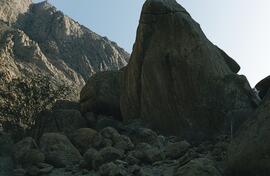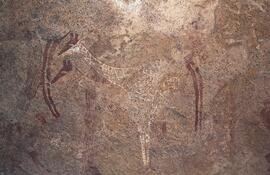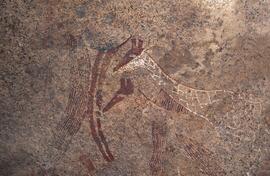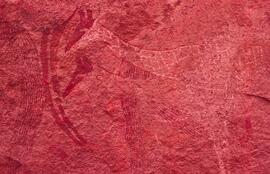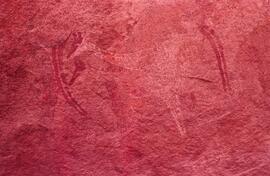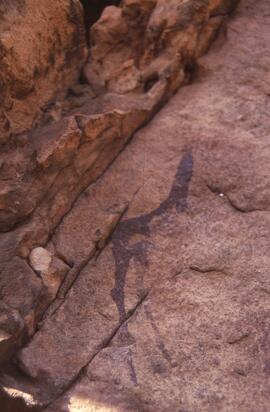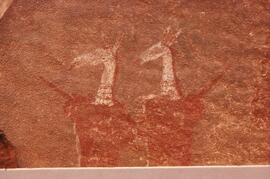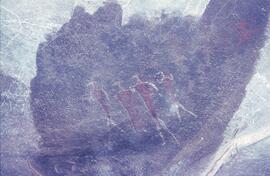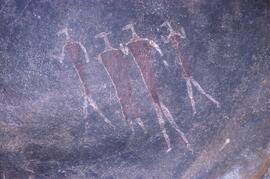Identity area
Reference code
Title
Date(s)
- 17/08/1995 (Creation)
Level of description
Extent and medium
Context area
Name of creator
Biographical history
Nationality: South African
Created by: azizo
Created on: 18/02/2003
Name of creator
Biographical history
Background of the Recorder
The Rock Art Research Institute had its small beginnings in 1979 when Professor David Lewis-Williams moved from the Social Anthropology Department at the University of the Witwatersrand to the Archaeology Department. A few years later, in 1983, he started a research project focused on surveying and recording the rock art of the Harrismith district, South Africa. This project was headed by Professor Lewis-Williams, with Bruce Fordyce as the only other researcher, and was funded by the Human Sciences Research Council (HSRC). This project grew and the necessity for interpretation of the rock art, not just finding the rock art sites, became a primary focus. In 1986 the entity became more widely recognized and, through a series of successful projects, achieved Unit status becoming the Rock Art Research Unit (RARU), with Professor Lewis-Williams as the director of the Unit. The HSRC still funded the Unit, and additional funding came from the Centre for Science Development, as well as from Wits University. Some of the people employed (full or part time, or as research students) by RARU are Terence Kohler (1984), Conrad Steenkamp (1984), Paul den Hoed (1984-1985), Zachary Kingdon (1986-1987), Colin Campbell (1987-1988), Thomas Dowson (1988-1994), Anne Holliday (1989-1995), Geoff Blundell (from 1993), Sven Ouzman (from 1993). In 2000, with the Professor Lewis-Williams's imminent retirement, Professor Barry Mendelow, then the Deputy Vice Chancellor, suggested that the Unit be ungraded to an institute. A unit is closed if the director leaves, but an institute can continue under different directorship. Institute status is the highest research status conferred by Wits University, and it was awarded to the Unit to recognise the high level of achievement in research publications and the breadth of research talent built up during Professor Lewis-Williams's twenty-one year directorship. Today the Rock Art Research Institute (RARI) is funded by the National Research Foundation, Wits University's own Research Fund and the Anglo-American Chairman's Fund. Some activities have been and are privately resourced. Dr Benjamin Smith became the new director of the Institute after Professor Lewis-Williams. He is still the director today. RARI is dedicated to developing an understanding of rock art by researching indigenous beliefs, rituals, customs and lifeways. Research is currently underway in all South African provinces as well as in Zimbabwe, Swaziland, Lesotho, Botswana, Mozambique, Zambia, Malawi, Tanzania and Kenya. Research therefore includes the rock arts of San and Pygmy hunter-gatherers, Khoi and Nilotic pastoralists, as well as of African farmers, such as the Chewa and the Northern Sotho. Underpinning this diverse research is a focus on the complex symbolism of African image-making. RARI has become one of the largest specialist rock art institutions in the world, attracting students and researchers from around the world. It is a leading centre for rock art training and offers undergraduate and post-graduate courses in rock art recording, interpretation and management. It is also active in rock art conservation and in the development and management of rock art tourism in South Africa. Included in these initiatives is the establishment of the Origins Centre in 2006 (www.origins.org.za), a world-class museum facility located in Johannesburg on the Wits University campus.
Repository
Archival history
Many of the slides depict art works which have either deteriorated seriously or have disappeared completely. Importance also lies in the thoroughness of the recordings. The sites visited were meticulously covered and the photographs annotated in detail.
The collection was built up by Neil Lee during 40 years of loving research conducted when his position as technical director at Lascon Lighting Industries would allow.
In a sense, the collection was born in the Middle East during the Second World War when Neil -then a member of RAF- became passionately interested in archaeological sites in which he was surrounded. When he moved to Durban with his South African wife, his enthusiasm for archaeology was channeled into rock art and his first studies took place in Natal under the guidance of Robby Steel, then a Giants Castle ranger and later an archaeological technician at Wits. Over the years, Neil has written articles for archaeological and popular magazines, has lectured in France, the United Kingdom, and the United States and with Bert Woodhouse, has published a book called 'Art on the Rocks'.
The Neil Lee Collection augments what is probably the largest archive of Bushman painting records in the world and will be invaluable in the further understanding of this art form.
Immediate source of acquisition or transfer
Content and structure area
Scope and content
Date of aquisition from: 17/08/1995
Date of aquisition to: 17/08/1995
Appraisal, destruction and scheduling
Accruals
System of arrangement
Conditions of access and use area
Conditions governing access
Conditions governing reproduction
Language of material
- English
Script of material
- Latin
Language and script notes
Physical characteristics and technical requirements
Finding aids
Allied materials area
Existence and location of originals
Existence and location of copies
Related units of description
Notes area
Note
In 1952 Neil was headhunted to be the technical manager for African Lamps and Thorn Electrical Industries in Johannesburg. At a party in 1953 he was approached by a man called Bert Woodhouse who asked to accompany Neil on his next field trip. This was the start of a partnership that would last for more than three decades and which saw Neil and Bert recording rock art in many areas, but particularly in the Free State. They spent every holiday and free weekend surveying for and recording rock art, often accompanied by their wives. Their base for eight years was an empty farmhouse near Slabberts, kindly made available to them by a local farmer. But, as time went on, they found themselves having to travel further and further away to find new sites and eventually they had to leave this base. Most of their work was privately funded, for a few years the work was supported by the CSIR and by Anglo American who eventually paid for the collection to be donated to the University of the Witwatersrand.
The decades of recording rock art culminated in the publication of a book called Art on the Rocks of South Africa in 1970.

